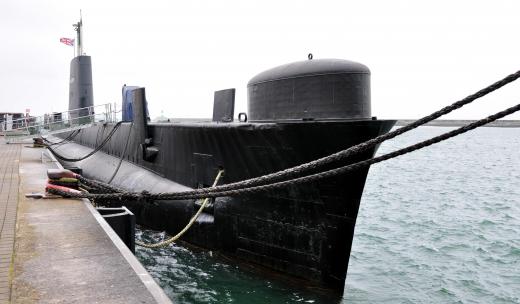How does a Submarine Work?
 Mary McMahon
Mary McMahon
A submarine is a type of watercraft that is designed to float on the surface and to navigate beneath the surface of the ocean. They range in size from very small submersibles designed for deep sea exploration to huge nuclear submarines maintained as part of a military fleet. All operate on the same basic principles, however, using the property of buoyancy to rise and fall in the water. The earliest model was built in the 1600s, although it was extremely crude and bears little resemblance to its modern counterparts.
The double hulled design of a submarine includes large spaces for ballast tanks. When the tanks are filled with air, the craft is much lighter than the water it displaces as it moves through the water, allowing it to float on the surface. When air is vented out so that water pours in, however, the submarine becomes heavier and starts to sink. Its exact depth can be controlled by admitting more water or forcing pressurized air into the ballast tanks.

The power plant of a submarine is designed to be highly efficient, so that the craft can navigate for months at a time. Diesel variations use diesel fuel connected to battery systems to power themselves. A nuclear submarine has a small nuclear power plant. By using nuclear power, the craft can remain submerged for a substantial amount of time.
Inside a submarine, conditions tend to be very cramped. Whether scientific or military, it is packed with gear pertaining to its use, and every available surface is utilized to maximum capacity. The staff can be in the hundreds on larger submarines, which also require extensive support services such as an infirmary, a mess hall, and accommodations. The power plant must also be used to generate oxygen and keep the air in the submarine clean so that the interior is a healthy living environment.

Many people are familiar with the periscope, a device used to look above the water while a submarine is submerged. A periscope consists of a set of mirrors mounted inside a long tube. When it is extended, a sailor puts his or her eye to the viewer and is able to see what is going on above the water. This tool can be used to look for threats, check on weather conditions, or make other quick general assessments. Some submarines also have a snorkel system to intake fresh oxygen.
AS FEATURED ON:
AS FEATURED ON:















Discussion Comments
Does anyone know if you can buy small personal submarines? Maybe there is a kit that I could buy to build my own small submarine. I've heard of submarines that were only the size of a person, and were powered by small motors. Any info would be great.
@ Anon1369- I think it depends on the type of submarine you are getting on. I have a buddy who went to the navy and was stationed on a submarine. He said the quarters were very small, and they would stay under water for long periods of time. I would think this would require serious amounts of training and mental preparedness. This would definitely not be for the faint of heart.
On the other hand, I went on a submarine tour of a coral reef, and it was like taking a party limo, just underwater. The submarine had four rows of long benches with portholes every couple of feet. We did a tour of an area reef, and got to see all kinds of fish, sharks, and eels. This submarine ride took no more preparation than riding a subway or taking a bus.
i have not been on a submarine yet but im going to be what should i be preparded for?
Post your comments